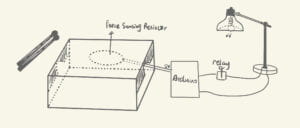Musical Light-Rachel Li-Margaret Minsky
Partner: Nicole (I’ve been thinking about what I should come up with this midterm project since Thursday and many ideas occurred to me that night. So I shared the ideas and the past versions of ideas with Nicole and we then agreed that the last version is an interesting one and we then decided to go on further with this “Musical Light” idea after we discussed it with Professor Minsky and got approval.)
Sketches and diagrams:

By Rachel Li
Project Explanation:
Users click the start button on Arduino and the mp3 will start playing a short piece of music, and they can then hit the cardboard-made drum, with a force sensor beneath, with a pair of drumsticks. When the music ends, the recording stops and the light starts to playback that beat created by the user, with an amazing light effect and the retro click-clack sound. I had this idea of using that click-clack sound as a beat when Professor Misky showed us the fascinating relay effect the light had on class, which is similar to the video link below.
How I came to this idea:
First version: When someone comes near enough, the light turns on automatically. And if it detects the person is out of the “interaction range” the light will repeat all that interaction part in a 1.25 speed, which I expect somehow makes a song by the click-clack beat. Disadvantage: no cardboard design. Improvement: make a drum with cardboard (or simply provide some “instruments” made of cardboard and participants hit the drum (or the instrument) to create different sounds. And a detector detects it and matches it with the nearest key or tone. And then an mp3 can play it into a song. How to remain the part of the light? 1. They’re two different parts of the song and the participants have to do both interactive activities to create a complete song with beats and tone. Maybe too complicated. New Idea💡 Second Version: Provide five short pieces of music and participants can hit the cardboard drum with straws, and make their own beat while they listen to the music. And something that can detect the beats can record them. And then we can make the light do the click-clack sound to replace the beat that is performed by the participants themselves, which is the part of recreation. A song is then created, with fascinating light effects and the retro click-clack sound!
